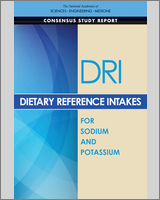NCBI Bookshelf. A service of the National Library of Medicine, National Institutes of Health.
As essential nutrients, sodium and potassium contribute to the fundamentals of physiology and pathology of human health and disease. In clinical settings, these are two important blood electrolytes, are frequently measured and influence care decisions. Yet, blood electrolyte concentrations are usually not influenced by dietary intake, as kidney and hormone systems carefully regulate blood values. Over the years, increasing evidence suggests that sodium and potassium intake patterns of children and adults influence long-term population health mostly through complex relationships among dietary intake, blood pressure and cardiovascular health. The public health importance of understanding these relationships, based upon the best available evidence and establishing recommendations to support the development of population clinical practice guidelines and medical care of patients is clear. This report reviews evidence on the relationship between sodium and potassium intakes and indicators of adequacy, toxicity, and chronic disease. It updates the Dietary Reference Intakes (DRIs) using an expanded DRI model that includes consideration of chronic disease endpoints, and outlines research gaps to address the uncertainties identified in the process of deriving the reference values and evaluating public health implications.
Contents
- The National Academies of SCIENCES • ENGINEERING • MEDICINE
- COMMITTEE TO REVIEW THE DIETARY REFERENCE INTAKES FOR SODIUM AND POTASSIUM
- Reviewers
- Preface
- Summary
- Part I
- Part II
- Part III
- 8. Sodium: Dietary Reference Intakes for Adequacy
- SODIUM ADEQUATE INTAKE LEVELS ESTABLISHED IN THE 2005 DRI REPORT
- REVIEW OF POTENTIAL INDICATORS OF SODIUM ADEQUACY
- ADDITIONAL EVIDENCE CONSIDERED: POTENTIAL HARMFUL HEALTH EFFECTS OF LOW SODIUM INTAKES
- DIETARY REFERENCE INTAKES OF SODIUM ADEQUACY
- SUMMARY OF UPDATED SODIUM ADEQUATE INTAKE VALUES
- REFERENCES
- 9. Sodium: Dietary Reference Intakes for Toxicity
- 10. Sodium: Dietary Reference Intakes Based on Chronic Disease
- REVIEW AND SELECTION OF CHRONIC DISEASE INDICATORS
- ASSESSMENT OF INTAKE–RESPONSE FOR CHRONIC DISEASE INDICATORS
- CHRONIC DISEASE RISK REDUCTION INTAKES FOR SODIUM
- SUMMARY
- REFERENCES
- References in Figures
- ANNEX 10-1 INDICATORS REVIEWED BUT NOT SELECTED
- ANNEX 10-1 REFERENCES
- ANNEX 10-2 EVALUATION OF BLOOD PRESSURE AS A SURROGATE MARKER OF HYPERTENSION AND CARDIOVASCULAR DISEASE FOR SODIUM INTAKE INTERVENTIONS
- ANNEX 10-2 REFERENCES
- 11. Sodium Dietary Reference Intakes: Risk Characterization and Special Considerations for Public Health
- 8. Sodium: Dietary Reference Intakes for Adequacy
- Part IV
- Appendix A. Acronyms and Abbreviations
- Appendix B. Open Session Agendas
- Appendix C. Committee's Assessment of the Agency for Healthcare Research and Quality Systematic Review
- Appendix D. Indicators Not Relevant for Establishing Dietary Reference Intake Values
- Appendix E. Supplemental Literature Searches
- Appendix F. Estimates of Potassium and Sodium Intakes from Breast Milk and Complementary Foods
- Appendix G. Sources of Evidence for Potassium and Sodium Intake Distributions
- Appendix H. Supplemental Risk Characterization Figures
- Appendix I. Committee Member Biographical Sketches
- Appendix J. Dietary Reference Intakes Summary Tables
Suggested citation:
National Academies of Sciences, Engineering, and Medicine. 2019. Dietary Reference Intakes for sodium and potassium. Washington, DC: The National Academies Press. doi: https://doi.org/10.17226/25353.
Digital Object Identifier: https://doi.org/10.17226/25353
Library of Congress Control Number: 2019940942
Additional copies of this publication are available from the National Academies Press, 500 Fifth Street, NW, Keck 360, Washington, DC 20001; (800) 624-6242 or (202) 334-3313; http://www.nap.edu.
Printed in the United States of America
- NLM CatalogRelated NLM Catalog Entries
- Review Dietary Reference Intakes for Calcium and Vitamin D[ 2011]Review Dietary Reference Intakes for Calcium and Vitamin DInstitute of Medicine (US) Committee to Review Dietary Reference Intakes for Vitamin D and Calcium, Ross AC, Taylor CL, Yaktine AL, Del Valle HB. 2011
- Review Sodium and Potassium Intake: Effects on Chronic Disease Outcomes and Risks[ 2018]Review Sodium and Potassium Intake: Effects on Chronic Disease Outcomes and RisksNewberry SJ, Chung M, Anderson CAM, Chen C, Fu Z, Tang A, Zhao N, Booth M, Marks J, Hollands S, et al. 2018 Jun
- A report of activities related to the Dietary Reference Intakes from the Joint Canada-US Dietary Reference Intakes Working Group.[Am J Clin Nutr. 2019]A report of activities related to the Dietary Reference Intakes from the Joint Canada-US Dietary Reference Intakes Working Group.MacFarlane AJ, Cogswell ME, de Jesus JM, Greene-Finestone LS, Klurfeld DM, Lynch CJ, Regan K, Yamini S, Joint Canada-US Dietary Reference Intakes Working Group. Am J Clin Nutr. 2019 Feb 1; 109(2):251-259.
- Current electrolyte intakes of infants and toddlers.[J Am Diet Assoc. 2006]Current electrolyte intakes of infants and toddlers.Heird WC, Ziegler P, Reidy K, Briefel R. J Am Diet Assoc. 2006 Jan; 106(1 Suppl 1):S43-51.
- Review Dietary Reference Intakes of sodium for Koreans: focusing on a new DRI component for chronic disease risk reduction.[Nutr Res Pract. 2022]Review Dietary Reference Intakes of sodium for Koreans: focusing on a new DRI component for chronic disease risk reduction.Kim HJ, Lee YK, Koo H, Shin MJ. Nutr Res Pract. 2022 May; 16(Suppl 1):S70-S88. Epub 2022 Mar 16.
- Dietary Reference Intakes for Sodium and PotassiumDietary Reference Intakes for Sodium and Potassium
Your browsing activity is empty.
Activity recording is turned off.
See more...
